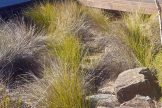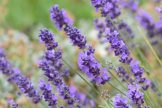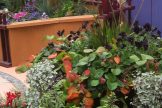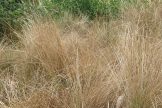
 Important note about plant availability. Important note about plant availability.There are hundreds of factsheets on our website provided for your information. Not all plants will be available at all times throughout the year. To confirm availability please call (03) 8850 3030 and ask for the nursery. |
Ferns are ancient plants, evolving millions of years ago. Ferns add a variety of foliage textures and shapes in varying shades of cool green to the house or garden.
Creating a Fern Garden
Ferns generally grow in shaded areas and have higher water requirements than other plants. Ferns will tolerate varying levels of shade from deep shade to morning sun and afternoon shade, and a few will tolerate full sun if their soil and moisture requirements are met.
Where to create your fern garden
Eastern or southern aspects are ideal for growing most ferns, whereas westerly and northerly aspects require overhead shade from other plants or shade cloth. Try to find the ideal spot in your garden. For example, under trees, in a cool damp spot protected from drying winds, where the humidity is higher.
What growing conditions do ferns require?
Ferns are particularly suited to damp shady corners of the garden, by ponds and water features and under constructed fernery areas. Ferns have high water requirements, and are best watered overhead with a fine mist to thoroughly soak the foliage and ground. Alternatively, micro sprays may be used to provide high humidity. Regular mulching, helps to retain soil moisture and keeps the roots cool.
What soil type is best for ferns and do they need fertiliser?
Ferns grow best in humus rich soils with good drainage and benefit from a light application of organic fertilizer in the warmer months. The humus content of soil may be raised by adding household compost, broken down leaf litter, or organic compost. Suitable organic fertilizers include Blood and Bone, any pelleted Organic Fertilizer, organic Liquid Fertilisers, and cow and sheep manure.
Looking After Your Fern Garden: Maintenance & care
Given ample shade and water, ferns require a minimum of cultivation and maintenance once they have become established. The only pruning needed with most ferns is the removal of dead or dying fronds, and trimming the rhizome of creeping species to limit their spread. Most ferns are easily propagated through germinating spores, planting plantlets, and planting sections of the rhizome of creeping species. A handout is available in the information stand on fern pests and diseases.
Pests and diseases to look out for on your ferns
Various pests and diseases may infect ferns, however, by maintaining healthy plants infection is less likely. It is also much easier to control pests without the use of expensive and toxic sprays if you regularly inspect plants. Try using organic control methods as many chemical sprays may burn fern foliage.
• Aphids – sap sucking insects that cause the fronds to deform and turn black. Control with Pyrethrum.
• Passion Vine Hopper – sap sucking insects which have a green hopping juvenile form with long white filaments at the end of the body and a brown delta winged adult form. These cause the ends of the fronds to die off. Control with applications of time release Pyrethrum.
• Scale – sap sucking insects, which look like black, brown green or white lumps. The plants may also have ants (which feed on the insect exudates, not on the plants), and sooty mould (a black substance on the leaves, again feeding on the scale exudates). Do not confuse scale with spores. Spores are produced under the fronds often arranged in patterns, rows or at the tips of fronds. New plants are produced from spores. Control scale by pruning off the effected frond or by using time release Pyrethrum. Do not use White Oil.
• Mites – very small sap sucking insects. Damage appears as silvering of the upper side of leaves and fine webbing on the undersides of leaves. To deter mites mist the undersides of the leaves regularly.
• Mealybugs – White sap sucking insects with oval bodies covered in short waxy threads. Control using Pyrethrum. May need repeated applications.
Being Creative with Ferns
The possibilities for using ferns in designs is extensive. There is an enormous range of leaf shapes, textures, leaf colours and growth habits. Some ideas include:
• Traditional naturalistic water features, ponds, rockeries, and cascades combined with an informal placement of various fern species. Rock ferns and native rock orchids (Dendrobiums) can be grown in rock crevices for a naturalistic rockery setting.
• Modern water features can be combined with strap leaved ferns such as Birds Nest Ferns, Holly Ferns, Felt Ferns, King Ferns, and tropical plants such as Cordylines, Canna Tropicana, Variegated Ginger, Syngoniums, and Cycads.
• Combine pots and selected sculptural pieces indoors with Birds Nest Ferns, Maidenhair Ferns, Stag and Elk Ferns, Cycads, Spathyphyllums and Orchids. On shaded walls combine Stag and Elk Ferns with Bromeliads, Native Orchids and Spanish Moss and add a wall plaque.
• There are many native species of fern available, and these can be combined with indigenous ground covers and shrubs (available in the indigenous section), mossy rocks and logs of wood to provide habitat for native frog and insect species. Make sure these areas are protected from cats and dogs and enjoy the wildlife attracted to your garden.
Some Planting Ideas
A Shady Corner of the Garden
1) Blechnum nudum
2) Asplenium australasicum
3) Acer palmatum ‘Green Cascade’
4) Pteris sp.
5) Dicksonia antarctica
6) Camellia japonica
7) Grevillea ‘John Evans’
A Trough full of Ferns
1) Ladder Fern
2) Maidenhair Fern
3) Hares Foot Fern or Caterpillar Fern
4) Crested Male Fern
5) Common Spleenwort
A Native Fern Garden
1) Adiantum aethiopicum (Common Maidenhair)
2) Asplenium bulbiferum (Hen and Chicken Fern)
3) Blechnum fluviatile (Ray Water Fern)
4) Blechnum watsii
5) Dicksonia antartica (Smooth Tree Fern)
6) Doodia aspera ( Prickly Rasp Fern)
7) Pellaea falcata (Button Fern)
8) Polystichum proliferum
9) Pteris tremula (Brake Fern)





